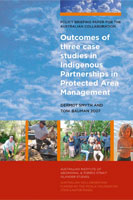Outcomes of three case studies in Indigenous Partnerships in Protected Area Management: Policy Briefing Paper
This briefing paper presents a summary of the findings and recommendations arising out of three case studies of Indigenous partnerships (joint management and other arrangements) in the management of protected areas in Australia.
The case studies were commissioned by the Poola Foundation (Tom Kantor Fund) in response to a joint proposal by the Australian Collaboration and the Australian Conservation Foundation. They form part of a wider ‘Success in Aboriginal Organisations’ project undertaken by the Australian Institute of Aboriginal and Torres Strait Islander Studies (AIATSIS) for the Australian Collaboration. This policy document is based on the findings reported in the more detailed and combined case study report.
The three case studies were chosen as examples of successful partnerships between Indigenous people with rights and interests in protected areas and government conservation agencies and others, which utilise a variety of legislative and policy mechanisms.
The case studies were:
- Nitmiluk National Park, which is Aboriginal land located near Katherine in the Northern Territory, leased to the Northern Territory government and jointly managed by Jawoyn traditional owners and the Northern Territory Parks and Wildlife Service
- Booderee National Park, which is Aboriginal land located in Jervis Bay Territory on the coast of south-eastern Australia, leased to the Australian government and jointly managed by the Wreck Bay Aboriginal Community Council and Parks Australia
- Dhimurru Indigenous Protected Area (IPA), which is Aboriginal land located adjacent to Nhulunbuy in north-eastern Arnhemland, declared as a protected area by Aboriginal traditional owners and managed by the Dhimurru Land Management Aboriginal Corporation with the support of both the Australian and Northern Territory governments.
